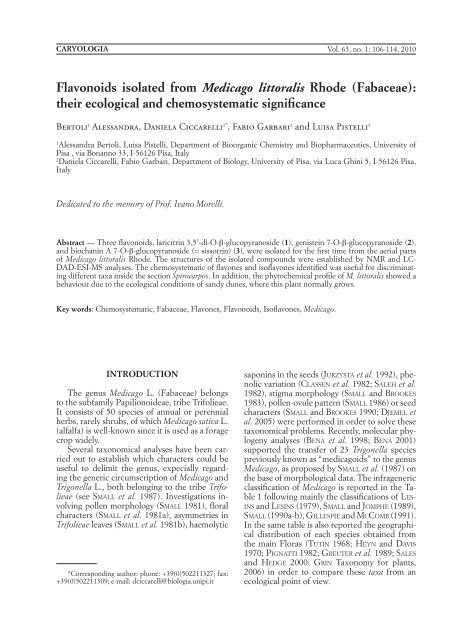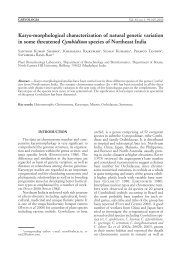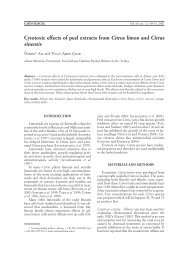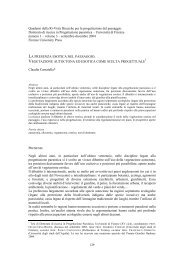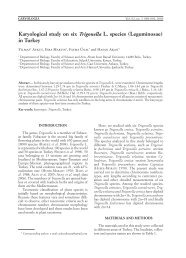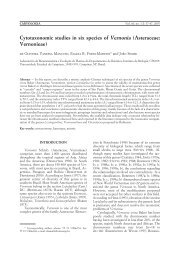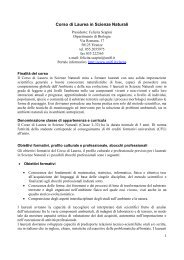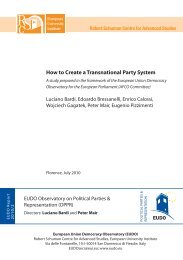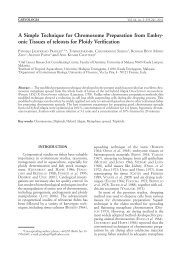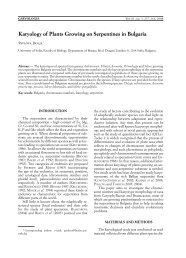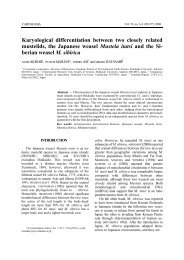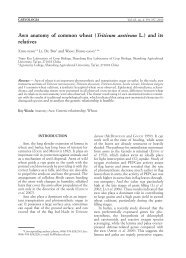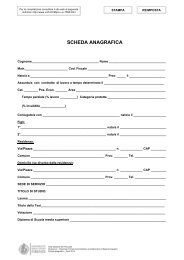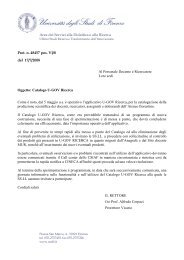Flavonoids isolated from Medicago littoralis Rhode (Fabaceae): their ...
Flavonoids isolated from Medicago littoralis Rhode (Fabaceae): their ...
Flavonoids isolated from Medicago littoralis Rhode (Fabaceae): their ...
You also want an ePaper? Increase the reach of your titles
YUMPU automatically turns print PDFs into web optimized ePapers that Google loves.
CARYOLOGIA Vol. 63, no. 1: 106-114, 2010<br />
<strong>Flavonoids</strong> <strong>isolated</strong> <strong>from</strong> <strong>Medicago</strong> <strong>littoralis</strong> <strong>Rhode</strong> (<strong>Fabaceae</strong>):<br />
<strong>their</strong> ecological and chemosystematic significance<br />
Bertoli 1 Alessandra, Daniela Ciccarelli 2* , Fabio Garbari 2 and Luisa Pistelli 1<br />
1<br />
Alessandra Bertoli, Luisa Pistelli, Department of Bioorganic Chemistry and Biopharmaceutics, University of<br />
Pisa , via Bonanno 33, I-56126 Pisa, Italy<br />
2<br />
Daniela Ciccarelli, Fabio Garbari, Department of Biology, University of Pisa, via Luca Ghini 5, I-56126 Pisa,<br />
Italy<br />
Dedicated to the memory of Prof. Ivano Morelli.<br />
Abstract — Three flavonoids, laricitrin 3,5’-di-O-β-glucopyranoside (1), genistein 7-O-β-glucopyranoside (2),<br />
and biochanin A 7-O-β-glucopyranoside (= sissotrin) (3), were <strong>isolated</strong> for the first time <strong>from</strong> the aerial parts<br />
of <strong>Medicago</strong> <strong>littoralis</strong> <strong>Rhode</strong>. The structures of the <strong>isolated</strong> compounds were established by NMR and LC-<br />
DAD-ESI-MS analyses. The chemosystematic of flavones and isoflavones identified was useful for discriminating<br />
different taxa inside the section Spirocarpos. In addition, the phytochemical profile of M. <strong>littoralis</strong> showed a<br />
behaviour due to the ecological conditions of sandy dunes, where this plant normally grows.<br />
Key words: Chemosystematic, <strong>Fabaceae</strong>, Flavones, <strong>Flavonoids</strong>, Isoflavones, <strong>Medicago</strong>.<br />
INTRODUCTION<br />
The genus <strong>Medicago</strong> L. (<strong>Fabaceae</strong>) belongs<br />
to the subfamily Papilionoideae, tribe Trifolieae.<br />
It consists of 50 species of annual or perennial<br />
herbs, rarely shrubs, of which <strong>Medicago</strong> sativa L.<br />
(alfalfa) is well-known since it is used as a forage<br />
crop widely.<br />
Several taxonomical analyses have been carried<br />
out to establish which characters could be<br />
useful to delimit the genus, expecially regarding<br />
the generic circumscription of <strong>Medicago</strong> and<br />
Trigonella L., both belonging to the tribe Trifolieae<br />
(see SMALL et al. 1987). Investigations involving<br />
pollen morphology (SMALL 1981), floral<br />
characters (SMALL et al. 1981a), asymmetries in<br />
Trifolieae leaves (SMALL et al. 1981b), haemolytic<br />
*Corresponding author: phone: +39(0)502211327; fax:<br />
+39(0)502211309; e-mail: dciccarelli@biologia.unipi.it<br />
saponins in the seeds (JURZYSTA et al. 1992), phenolic<br />
variation (CLASSEN et al. 1982; SALEH et al.<br />
1982), stigma morphology (SMALL and BROOKES<br />
1983), pollen-ovule pattern (SMALL 1986) or seed<br />
characters (SMALL and BROOKES 1990; DJEMEL et<br />
al. 2005) were performed in order to solve these<br />
taxonomical problems. Recently, molecular phylogeny<br />
analyses (BENA et al. 1998; BENA 2001)<br />
supported the transfer of 23 Trigonella species<br />
previously known as “medicagoids” to the genus<br />
<strong>Medicago</strong>, as proposed by SMALL et al. (1987) on<br />
the base of morphological data. The infrageneric<br />
classification of <strong>Medicago</strong> is reported in the Table<br />
1 following mainly the classifications of LES-<br />
INS and LESINS (1979), SMALL and JOMPHE (1989),<br />
SMALL (1990a-b), GILLESPIE and MCCOMB (1991).<br />
In the same table is also reported the geographical<br />
distribution of each species obtained <strong>from</strong><br />
the main Floras (TUTIN 1968; HEYN and DAVIS<br />
1970; PIGNATTI 1982; GREUTER et al. 1989; SALES<br />
and HEDGE 2000; GRIN Taxonomy for plants,<br />
2006) in order to compare these taxa <strong>from</strong> an<br />
ecological point of view.
RUNNING TITLE: FLAVONOIDS IN MEDICAGO LITTORALIS RHODE 107<br />
TABLE 1 — The infrageneric classification and the geographical distribution of <strong>Medicago</strong> L. <strong>from</strong> the Mediterranean<br />
region, Middle East and Asia. Evidenced in bold the species living on maritime sands or extending <strong>their</strong> area of occupancy<br />
up to the seashore.<br />
Section Subsection Species Geographical distribution<br />
Dendrotelis M. arborea L. Rocky places. Mediterranean region, Middle East and Asia.<br />
M. strasseri Greuter, Matthäs & Risse Rocky places. Europe.<br />
<strong>Medicago</strong> M. cancellata M. Bieb. Steppe. Russian Federation.<br />
M. daghestanica Rupr. Steppe. Russian Federation.<br />
M. hybrida Trautv. Woods and mountain slopes. Corbiéres and Pyrenees.<br />
M. marina L. Maritime sands. Shores of the Mediterranean, Black Sea and Atlantic.<br />
M. papillosa Boiss. Middle East and Asia.<br />
M. pironae Vis. Rocky places. Italy and Balcans.<br />
M. prostrata Jacq. Dry grassland. From Italy and Austria to the Black Sea.<br />
M. rhodopaea Velen. Rocky places. Bulgaria.<br />
M. rupestris M. Bieb. Rocky places. Krym.<br />
M. sativa L. Cosmopolitan.<br />
M. saxatilis M. Bieb. Rocky places. Bulgaria and Krym.<br />
M. suffruticosa Raymond Rocky places. Pyrenees and Morocco.<br />
Carstienses M. carstiensis Jacq. Bushy places. From Italy to Bulgaria.<br />
Spirocarpos Pachyspirae M. constricta Durieu Grasslands. Europe and Asia.<br />
M. doliata Carmign. Dry lands. Mediterranean region and Middle East.<br />
M. italica Mill. (= M. tornata (L.) Miller) Dry grasslands. Mediterranean region extending to Portugal.<br />
M. lesinsii E. Small Mediterranean region.<br />
M. <strong>littoralis</strong> Rohde Mediterranean region extending to Portugal and W. France.<br />
M. murex Willd Mediterranean region extending to Portugal.<br />
M. rigidula L. Dry grasslands. South Europe.<br />
M. rigiduloides E. Small Middle East, Caucasus and Asia.<br />
M. sinskiae Uljanova Asia.<br />
M. soleirolii Duby Dry grasslands. Krym, probably introduced in Italy and France.<br />
M. syriaca E. Small Syria.<br />
M. truncatula Gaertn. Mediterranean region.<br />
M. turbinata L. Mediterranean region.<br />
Rotatae M. blancheana Boiss. Mediterranean region.<br />
M. noeana Boiss. Iraq and Turkey.<br />
M. rotata Boiss. Eastern Mediterranean region.<br />
M. rugosa Desr. Mediterranean region living also on maritime sands.<br />
M. scutellata L. Grasslands. South Europe.<br />
M. shepardii Post Turkey.<br />
Intertextae M. ciliaris L.<br />
Mediterranean region.<br />
M. granadensis Willd. Mediterranean region.<br />
M. intertexta L. Grasslands, expecially near the sea. Mediterranean region and Portugal.<br />
M. muricoleptis Tineo Grasslands, expecially near the sea. Mediterranean region.<br />
Leptospirae M. arabica L.<br />
Cosmopolitan. Mediterranean region.<br />
M. coronata L. Stenomediterranean.<br />
M. disciformis DC. Stenomediterranean.<br />
M. laciniata L. Naturalized locally in the Mediterranean region.<br />
M. lanigera C. Winkl. Afghanistan, Tajikistan and Turkmenistan.<br />
M. laxispira Heyn Iraq.<br />
M. minima L. Living on sandy dunes. Most of Europe.<br />
M. polymorpha L. Subcosmopolitan. South Europe.<br />
M. praecox DC. Dry lands and garrigues. Mediterranean region.<br />
M. sauvagei Nègre Morocco.<br />
M. tenoreana Ser. Mediterranean region.
108<br />
BERTOLI, CICCARELLI, GARBARI and PISTELLI<br />
Table 1 Contd.<br />
Section Subsection Species Geographical distribution<br />
Geocarpa M. hypogaea E. Small Eastern Mediterranean region.<br />
Lupularia M. lupulina L. Throughout Europe.<br />
M. secundiflora Durieu Mediterranean region.<br />
Heynianae M. heyniana Greuter Europe and Middle East.<br />
Orbiculares M. orbicularis L. South Europe.<br />
Hymenocarpos M. radiata L. Afghanistan, Iran, Iraq, Israel, Jordan, Lebanon, Syria, Turkey and Caucasus.<br />
Platycarpae M. archiducis-nicolai Širj. China.<br />
M. cretacea M. Bieb. Ukraine, Krym and Asia.<br />
M. edgeworthii Širj. Asia.<br />
M. ovalis Širj. Spain, Algeria and Morocco.<br />
M. platycarpa L. Russian Federation and Asia.<br />
M. plicata Širj. Turkey.<br />
M. popovii Širj. Soviet Middle Asia.<br />
M. ruthenica (L.) Ledebour Russian Federation and Asia.<br />
Lunatae M. biflora E. Small Turkey and Caucasus.<br />
M. brachycarpa M. Bieb. Iraq, Lebanon, Turkey and Caucasus.<br />
M. huberi E. Small Turkey.<br />
M. rostrata E. Small Turkey.<br />
Buceras Erectae M. arenicola E. Small Turkey.<br />
M. astroites Trautv. Iran, Iraq, Israel, Jordan, Lebanon, Syria, Turkey, Caucasus and Soviet Middle Asia.<br />
M. carica E. Small East Aegean islands and Asiatic Turkey.<br />
M. crassipes E. Small Iran, Iraq, Lebanon, Syria and Turkey.<br />
M. fischeriana Trautv. Bulgaria.<br />
M. halophila E. Small Turkey.<br />
M. heldreichii E. Small Turkey.<br />
M. medicaginoides E. Small Europe, Middle East and Asia.<br />
M. monantha Trautv. Afghanistan, Iran, Iraq, Israel, Jordan, Lebanon, Syria, Turkey, Caucasus and Soviet<br />
Middle Asia.<br />
M. orthoceras Trautv. Iran, Iraq, Turkey, Caucasus and Soviet Middle Asia.<br />
M. pamphylica E. Small Turkey.<br />
M. persica E. Small Iran.<br />
M. phrygia E. Small Iran, Iraq, Syria and Turkey.<br />
M. polyceratia Trautv. France, Portugal, Spain, Algeria, Morocco and Tunisia.<br />
M. rigida E. Small Turkey.<br />
Deflexae M. retrorsa E. Small Afghanistan.<br />
Reflexae M. monspeliaca Trautv. Mediterranean region.<br />
Isthmocarpae M. isthmocarpa E. Small Turkey.<br />
M. rhytidiocarpa E. Small Turkey.<br />
The present report represents the first result<br />
of a phytochemical study of Italian populations<br />
of <strong>Medicago</strong> <strong>littoralis</strong> <strong>Rhode</strong> (strand medic).<br />
This species is a therophyte growing on sandy<br />
soils near the sea and distributed in the Mediterranean<br />
region extending to Portugal and<br />
West France. Whole plant is covered by hair;<br />
the leaves are ternate with obovate or cordate,<br />
cuneate, dentate towards the apex leaflets. The<br />
yellow flowers are grouped in a terminal raceme;<br />
flowering in March-May. The legumes are in a<br />
very close spiral of 3-6 turns, discoid to cilindrical,<br />
glabrous, spiny or not (TUTIN 1968).<br />
There are few photochemical studies on the
RUNNING TITLE: FLAVONOIDS IN MEDICAGO LITTORALIS RHODE 109<br />
TABLE 2 — Distribution of flavonoids in the genus <strong>Medicago</strong>. The species that living on maritime sands or extending<br />
<strong>their</strong> area up to the seashore are evidenced in bold.<br />
Species Flavonols Isoflavones Flavones Isoflavans Pterocarpans Coumestans<br />
Sec. Dendrotelis<br />
M. arborea a,b x x x<br />
Sec. <strong>Medicago</strong><br />
M. cancellata a,b x<br />
M. hybrida a,b x<br />
M. marina a,b x x<br />
M. sativa a,b,d,e,f x x x x x x<br />
Sec. Spirocarpos<br />
Subsec. Pachyspirae<br />
M. doliata a,b x x x<br />
M. <strong>littoralis</strong> a,b x x x x x<br />
M. murex a,b x<br />
M. rigidula a,b x x<br />
M. truncatula a,b,c x x x x<br />
M. turbinata a,b x<br />
Subsec. Rotatae<br />
M. blancheana a,b x<br />
M. rotata a,b x<br />
M. scutellata a,b x x x<br />
Subsec. Intertextae<br />
M. ciliaris a,b x x x x<br />
M. intertexta a,b x x x x<br />
Subsec. Leptospirae<br />
M. arabica a,b x x x x x<br />
M. coronata a,b x x<br />
M. laciniata a,b x x x<br />
M. minima a,b x x x<br />
M. polymorpha a,b x x x x<br />
Sec. Geocarpa<br />
M. hypogaea a,b x x<br />
Sec. Lupularia<br />
M. lupulina a,b x x<br />
Sec. Orbiculares<br />
M. orbicularis a,b x x x x x<br />
Sec. Hymenocarpos<br />
M. radiata a,b x x x x x<br />
Sec. Platycarpae<br />
M. cretacea a,b x<br />
M. platycarpa a,b x x<br />
Sec. Buceras<br />
Subsec. Erectae<br />
M. medicaginoides a,b x<br />
M. monantha a,b x<br />
M. polyceratia a,b x<br />
Subsec. Reflexae<br />
M. monspeliaca a,b x x x<br />
Phytochemical data source: a = Southon (1994); b = Hegnauer and Hegnauer (2001); c = Kowalska et al. (2007); d = Stochmal<br />
et al. (2001a); e = Stochmal et al. (2001b); f = Stochmal et al. (2001c).
110<br />
BERTOLI, CICCARELLI, GARBARI and PISTELLI<br />
(1) Laricitrin 3,5-O-β-diglucopyranoside<br />
(2) Genistein 7-O-β-glucopyranoside R=H<br />
(3) Biochanin A7-O-β-glucopyranoside R=Me<br />
Figure 1 — Chemical structures of the flavonoids (1-3)<br />
<strong>isolated</strong> <strong>from</strong> the aerial parts of <strong>Medicago</strong> <strong>littoralis</strong>.<br />
aerial green parts of M. <strong>littoralis</strong> collected out<br />
of Italy (INGHAM 1979; SALEH et al. 1982), which<br />
show the presence of several typical compounds<br />
such as daidzein, luteolin, medicarpin, sativan,<br />
3’,4’,7-trihydroxyisoflavone and vestitol. Previous<br />
phytochemical studies on the genus <strong>Medicago</strong><br />
showed the presence of flavones, flavonols,<br />
isoflavones, isoflavans, coumestans and pterocarpans<br />
(SOUTHON 1994; HEGNAUER and HEG-<br />
NAUER 2001; STOCHMAL et al. 2001a-c; KOWALSKA<br />
et al. 2007). The aim of this paper was the isolation<br />
and the characterization of some typical<br />
flavonoids of M. <strong>littoralis</strong> aerial parts collected<br />
in sandy dunes to suggest chemosystematic considerations.<br />
MATERIALS AND METHODS<br />
Plant material - The plant grows on the back of<br />
sandy dunes of Marina di Vecchiano (Pisa, Italy)<br />
within the Natural Park of Migliarino - San Rossore<br />
- Massacciuccoli. Aerial parts of <strong>Medicago</strong><br />
<strong>littoralis</strong> were randomly collected <strong>from</strong> the same<br />
population during the flowering phase at the<br />
end of April 2004. A voucher specimen (3688/4)<br />
was deposited in the Herbarium Horti Botanici<br />
Pisani (PI), Italy.<br />
Chemicals and equipments - Acetonitrile,<br />
HCOOH and methanol were HPLC grade solvents<br />
by Baker (Netherlands). HPLC-Water was<br />
purified by a Milli-Q Plus system (Millipore Milford,<br />
MA, USA). Reference chemical material including<br />
luteolin, daidzein, and the <strong>isolated</strong> compounds<br />
(laricitrin 3,5’-di-O-β-glucopyranoside,<br />
genistein 7-O-β-glucopyranoside and biochanin<br />
A 7-O- β-glucopyranoside) were part of an<br />
home-made database where each compound<br />
was used as standard with an HPLC grade purity<br />
of 98-99%. The analysis were performed by<br />
a Surveyor Thermofinnigan liquid chromatograph<br />
pump equipped with a Thermofinnigan<br />
Photodiode Array Detector and a LCQ Advantage<br />
mass detector. The semipreparative HPLC<br />
system consisted of a Waters 600E (Millipore)<br />
pump and 990 photodiode array detector (PDA)<br />
and a column Merck LiChroCART 250RP-18<br />
column (30 x 1 cm, 10 µm) was used.<br />
Extraction and LC-DAD-MS screening - The aerial<br />
parts (184 g) of <strong>Medicago</strong> <strong>littoralis</strong>, air-dried at<br />
room temperature and powdered, were extracted<br />
in a Soxhlet apparatus with n-hexane, CHCl 3<br />
and<br />
MeOH in turn. After removal of solvent under<br />
vacuum, the following residues were obtained:<br />
R H<br />
(5.49 g), R C<br />
(6.53 g), and R M<br />
(25.81 g).<br />
R M<br />
(3.73 g) was chromatographed on a Merck<br />
Lichroprep RP-8 column (40-63 mm) eluted<br />
with MeOH-H 2<br />
O (7:3) to obtain 19 crude fractions<br />
(M 1<br />
-M 19<br />
). Fractions were checked by TLC<br />
[RP-18, MeOH-H 2<br />
O (7:3)], Merck Kieselgel 60<br />
F 254<br />
. TLC chromatograms were visualized under<br />
UV light at 254 and 366 nm and sprayed with<br />
Naturstoffreagents-PEG. The most interesting<br />
purified fractions were screened by LC-DAD-<br />
ESI-MS using an analytical Lichrosorb RP-18<br />
column (250 x 4.6 mm i.d., 5μm, Merck). The<br />
analyses (20 μl, 2 mg/ml methanolic extract solution)<br />
were carried out by a linear gradient using<br />
water with 0.1% HCOOH (solvent A), CH-<br />
CN (solvent B) and MeOH (solvent C) at flow<br />
3<br />
rate of 1.0 ml/min in the following conditions:<br />
<strong>from</strong> 20:80 v/v (B-A) to 40:60 (B-A) in 20 min,<br />
then to 40:60 v/v (B-A) (20 min), and then conditioning<br />
to the initial condition (20:80 v/v B-A)<br />
for 10 min. The total analytical run time was 50<br />
min for each sample. The spectral data <strong>from</strong> the<br />
PDA detector were collected during the whole<br />
run in the range 210-500 nm and the peaks were<br />
detected at 330 nm for all analysed compounds.<br />
LC-ESI-MS analyses were performed in the same<br />
chromatographic conditions using these specific
RUNNING TITLE: FLAVONOIDS IN MEDICAGO LITTORALIS RHODE 111<br />
electrospray ionization values: sheath gas flowrate<br />
72 psi, auxilary gas flow 10 psi, capillary<br />
voltage -16 V and capillary temperature 280°C<br />
. Full scan spectra <strong>from</strong> m/z 200 to 500 amu in<br />
the negative ion mode were obtained. The identification<br />
of each constituents was carried out by<br />
the comparison of each peak in the extracts with<br />
the retention times, UV and MS spectra of an<br />
home-made database of flavonoid compounds.<br />
Isolation and purification of flavonoids - The filtered<br />
solution of fraction M 2<br />
(1 g) was subjected<br />
to column chromatography over a Merck Lichroprep<br />
RP-8 column (40-63 µm) eluted with<br />
MeOH-H 2<br />
O (3:7) to obtain 11 subfractions<br />
(E 1<br />
-E 11<br />
). Subfraction E 7<br />
(30 mg) was purified<br />
by semipreparative HPLC-PDA. The gradient<br />
profiles were based on two solvents, denoted<br />
A (CH 3<br />
CN) and B (H 2<br />
O), were employed. Initial<br />
conditions were 20% A, 80% B with a linear<br />
gradient reaching 40% A, 60% B; this was<br />
followed by isocratic elution, after which the<br />
programme returned to the initial solvent composition<br />
(t = 40 min). Column was mantained<br />
at room temperature, and the flow rate was 1.3<br />
ml/min. Injection volumes were 100 μl, and UV<br />
detection was at 330 nm. This semipreparative<br />
HPLC/UV gave 4 subfractions (E 7.1<br />
-E 7.4<br />
). Fraction<br />
M 4<br />
was subjected to column chromatography<br />
under the same conditions of fraction M 2<br />
to<br />
obtain 2 subfractions (M 4.1<br />
-M 4.2<br />
).<br />
The nuclear magnetic resonance (NMR)<br />
spectra of the <strong>isolated</strong> flavonoids were registered<br />
on a Bruker AC-200 spectrometer and a<br />
Bruker Avance 400 spectrometer using CD 3<br />
OD<br />
or DMSO-d 6<br />
as solvent. TMS was used as internal<br />
standard. All the 1D and 2D NMR experiments<br />
were carried on using the standard<br />
Bruker library of microprograms. MS spectra of<br />
the <strong>isolated</strong> compounds were registered by direct<br />
infusion in LCQ Advantage ion trap mass<br />
spectrometer using a methanolic solution (1 μg/<br />
ml, 5 μl/min) with the following ESI parameters:<br />
sheath gas flow-rate 72 arbitrary units, auxilary<br />
gas flow 10 arbitrary units, capillary voltage -16<br />
V and capillary temperature 280°C.<br />
RESULTS AND DISCUSSION<br />
The preliminary screening by LC-DAD-ESI-<br />
MS analyses of <strong>Medicago</strong> <strong>littoralis</strong> (aerial parts)<br />
collected during the flowering phase on the<br />
sandy dunes of Marina di Vecchiano (Pisa, Italy)<br />
showed the presence of some characteristic flavonoids<br />
such as lutein and daidzein previously<br />
reported in the literature (SOUTHON 1994; HEG-<br />
NAUER and HEGNAUER 2001).<br />
However, our phytochemical investigation<br />
on this species showed also laricitrin 3,5’-di-<br />
O-β-glucopyranoside (1), genistein 7-O-βglucopyranoside<br />
(2), and biochanin A 7-O-β<br />
-glucopyranoside (= sissotrin) (3) as characteristic<br />
compounds (Fig. 1). These flavonoids were<br />
<strong>isolated</strong> for the first time in <strong>Medicago</strong> <strong>littoralis</strong>.<br />
After the extraction, the methanolic extract<br />
was chromatographed by semi-preparative<br />
HPLC to isolate the constituents. Subfractions<br />
E 7.2<br />
(2 mg) and E 7.4<br />
(2 mg) gave pure compounds<br />
(1) and (2), respectively. Compound (3) was<br />
identified as pure constituent of subfraction M 4.1<br />
(2.8 mg). The structural elucidation of the <strong>isolated</strong><br />
compounds were performed on the basis<br />
of NMR and ESI-MS experiments.<br />
The signals in the 1 H and 13 C NMR spectra<br />
of the isolates were superimposable on those reported<br />
in the literature for laricitrin 3,5’-di-O-βglucopyranoside<br />
(1) (TORCK et al. 1983; KOWAL-<br />
SKA et al. 2007), genistein 7-O-β-glucopyranoside<br />
(2) (AGRAVAL 1989), and biochanin A 7-O-βglucopyranoside<br />
(= sissotrin) (3) (GUGGOLZ et<br />
al. 1961).<br />
Except for laricitrin 3,5’-di-O-β-glucopyranoside,<br />
<strong>isolated</strong> in the floral parts of M. arborea<br />
L. (TORCK et al. 1983), M. lupulina L. (BURDA<br />
and JURZYSTA 1988) and M. truncatula Gaertn.<br />
(KOWALSKA et al. 2007), the other flavonoids<br />
had never been recorded in the genus <strong>Medicago</strong>.<br />
Previous phytochemical studies showed the<br />
presence of luteolin, daidzein and 3’,4’,7-trihydroxyisoflavone<br />
in the hydrolized plant of M. <strong>littoralis</strong><br />
(SALEH et al. 1982), while sativan, vestitol<br />
and medicarpin were <strong>isolated</strong> <strong>from</strong> the leaves of<br />
the same species (INGHAM 1979).<br />
<strong>Flavonoids</strong> are well accepted as chemical<br />
markers in plant taxonomy as a useful tool for<br />
the characterization and classification of higher<br />
plants, because of <strong>their</strong> widespread occurrence<br />
and chemical stability (HARBORNE and TURNER<br />
1984; HEGNAUER and HEGNAUER 2001).<br />
Regarding a significant connection between<br />
the distribution of secondary metabolites and<br />
the infrageneric classification of <strong>Medicago</strong> (Table<br />
2), it seems clear that flavones and isoflavones<br />
may be particularly useful for discriminating different<br />
taxa inside the section Spirocarpos Ser. Isoflavones,<br />
in fact, occur in the subsections Intertextae<br />
(Urb.) Heyn and Leptospirae (Urb.) Heyn,<br />
but they are absent in Pachyspirae (Urb.) Heyn<br />
(except for M. <strong>littoralis</strong>). In the same way as re-
112<br />
BERTOLI, CICCARELLI, GARBARI and PISTELLI<br />
TABLE 3 — <strong>Flavonoids</strong> <strong>from</strong> M. <strong>littoralis</strong> and <strong>their</strong> occurrence in the genus <strong>Medicago</strong>. The species that living on maritime<br />
sands or extending <strong>their</strong> area up to the seashore are evidenced in bold.<br />
Species Flavonols Isoflavones Flavones Isoflavans Pterocarpans<br />
1 2 3 4 5 6 7 8 9<br />
Sec. Dendrotelis<br />
M. arborea x x x<br />
Sec. <strong>Medicago</strong><br />
M. cancellata<br />
M. hybrida<br />
M. marina x x<br />
M. sativa x x x x x x<br />
Sec. Spirocarpos<br />
Subsec. Pachyspirae<br />
M. doliata x x x<br />
M. <strong>littoralis</strong> x x x x x x x x x<br />
M. murex<br />
M. rigidula x x<br />
M. truncatula x x x x<br />
M. turbinata<br />
Subsec. Rotatae<br />
M. blancheana<br />
M. rotata<br />
M. scutellata x<br />
Subsec. Intertextae<br />
M. ciliaris x x x<br />
M. intertexta x x x x<br />
Subsec. Leptospirae<br />
M. arabica x x x x<br />
M. coronata x x x<br />
M. laciniata x x<br />
M. minima x x x<br />
M. polymorpha x x x<br />
Sec. Geocarpa<br />
M. hypogaea<br />
Sec. Lupularia<br />
M. lupulina x x<br />
Sec. Orbiculares<br />
M. orbicularis x x x x x x<br />
Sec. Hymenocarpos<br />
M. radiata x x x<br />
Sec. Platycarpae<br />
M. cretacea<br />
M. platycarpa x<br />
Sec. Buceras<br />
Subsec. Erectae<br />
M. medicaginoides<br />
M. monantha<br />
M. polyceratia<br />
Subsec. Reflexae<br />
M. monspeliaca x x x<br />
1 = Laricitrin 3,5’-O-glc; 2 = Genistein 7-O-glc; 3 = Sissotrin; 4 = Daidzein; 5 = 3’,4’,7-trihydroxyisoflavone; 6 = Luteolin; 7<br />
= Sativan; 8 = Vestitol; 9 = Medicarpin.
RUNNING TITLE: FLAVONOIDS IN MEDICAGO LITTORALIS RHODE 113<br />
gards flavones, it is interesting that these compounds<br />
occur in the subsection Leptospirae, but<br />
they are absent in Pachyspirae except again for<br />
M. <strong>littoralis</strong>. Our results are partially in accordance<br />
with molecular phylogenetic studies (BENA<br />
et al. 1998) and biochemical analyses of seed<br />
composition that show M. truncatula and M. <strong>littoralis</strong><br />
as very closely related species (DJEMEL et<br />
al. 2005). M. truncatula, in fact, shows the same<br />
phytochemical profile of M. <strong>littoralis</strong> except for<br />
isoflavones (KOWALSKA et al. 2007).<br />
Moreover, this study was carried out in order<br />
to find relationships between the phytochemical<br />
profile of M. <strong>littoralis</strong> and the ecological conditions<br />
of sandy dunes, where the plants grows.<br />
M. <strong>littoralis</strong> is able to synthesise flavonols, isoflavones,<br />
flavones, isoflavans and pterocarpans<br />
(SOUTHON 1994; HEGNAUER and HEGNAUER<br />
2001). This behaviour is also found in M. sativa,<br />
M. arabica, M. orbicularis and M. radiata (Table<br />
2), which belong to different sections or subsections<br />
and live in different habitats. Anyway, if<br />
we consider the specific flavonoid and not the<br />
chemical class (see Table 3), the mentioned species<br />
produce different flavonoids.<br />
All the plants that live on maritime sands<br />
were able to synthesize flavonols (except for M.<br />
marina L., M. coronata L. and M. minima L.) and<br />
most of them produced isoflavones and flavones<br />
depending on the subsection considered. On the<br />
other hand, considering flavonoids <strong>isolated</strong> <strong>from</strong><br />
M. <strong>littoralis</strong> samples and <strong>their</strong> occurrence in the<br />
genus <strong>Medicago</strong> (see Table 2-3), a so large variety<br />
in the flavonoidic composition has never been<br />
observed for plants living near the sea yet.<br />
In conclusion, this study showed laricitrin<br />
3,5’-di-O-β-glucopyranoside (1), genistein<br />
7-O-β-glu co pyra noside (2), and sissotrin (3) as<br />
characteristic flavonoids of the aerial parts of M.<br />
<strong>littoralis</strong> collected on the sandy dunes during the<br />
flowering period. Therefore, the list of chemotaxonomic<br />
markers of M. <strong>littoralis</strong> can be added<br />
by these flavonoids (1-3). To evaluate more<br />
deeply the flavonoidic production in this species,<br />
the authors plan to study its phytochemical<br />
profile also during seasonal and growth-phase<br />
variations.<br />
REFERENCES<br />
AGRAVAL P.K., 1989 — Carbon-13 NMR of <strong>Flavonoids</strong>.<br />
Elsevier, Amsterdam.<br />
BENA G., 2001 — Molecular Phylogeny supports the<br />
morphologically based taxonomic transfer of the<br />
“medicagoid” Trigonella species to the genus <strong>Medicago</strong><br />
L. Plant Systematics and Evolution, 229:<br />
217-236.<br />
BENA G., LEJEUNE B., PROSPERI J.M. and OLIVIERI I.,<br />
1998 — Molecular phylogenetic approach for studying<br />
life-history evolution: the ambiguous example<br />
of the genus <strong>Medicago</strong>. Proceedings of the Royal<br />
Society London B, 265: 1141-1151.<br />
BURDA S. and JURZYSTA M., 1988 — Isolation and<br />
identification of flavonoids <strong>from</strong> <strong>Medicago</strong> lupulina<br />
L. flowers. Acta Societatis Botanicorum Poloniae,<br />
57: 563-571.<br />
CLASSEN D., NOZZOLILLO C. and SMALL E., 1982 — A<br />
phenolic-taxometric study of <strong>Medicago</strong> (Leguminosae).<br />
Canadian Journal of Botany, 60: 2477-<br />
2495.<br />
DJEMEL N., GUEDON D., LECHEVALIER A., SALON C.,<br />
MIQUEL M., PROSPERI J.-M., ROCHAT C. and BOU-<br />
TIN J.-P., 2005 — Development and composition of<br />
the seeds of nine genotypes of the <strong>Medicago</strong> truncatula<br />
species complex. Plant Physiology and Biochemistry,<br />
43: 557-566.<br />
GILLESPIE D.J. and MCCOMB J.A., 1991 — Morphology<br />
and distribution of species in the <strong>Medicago</strong><br />
murex complex. Canadian Journal of Botany, 69:<br />
2655-2662.<br />
GREUTER W., BURDET H.M. and LONG G., 1989 —<br />
Med-Checklist, vol. 4, pp 136-147. Conservatoire<br />
et Jardin botaniques, Genéve.<br />
GRIN Taxonomy for Plants. 2006. URL: http://www.<br />
ars-grin.gov/<br />
GUGGOLZ J., LIVINGSTON A.L. and BICKOFF E.M.,<br />
1961 — Detection of Daidzein, Formononetin,<br />
Genistein and Biochanin A in forages. Journal of<br />
Agricultural and Food Chemistry, 9: 330-332.<br />
HARBORNE J.B. and TURNER B.L., 1984 — Plant chemiosystematics.<br />
Harcourt Brace Jovanovich Publishers,<br />
Academic Press, London.<br />
HEGNAUER R. and HEGNAUER M., 2001 — Chemotaxonomie<br />
der Pflanzen. Band XIb-2: Leguminosae.<br />
Teil 3: Papilionoideae. Birkhäuser Verlag, Basel.<br />
HEYN C.C. and DAVIS P.H., 1970 — <strong>Medicago</strong> L. In:<br />
P.H. Davis (Ed.) “Flora of Turkey and the East<br />
Aegean Islands”, vol. 3, pp 483-511. Edinburgh<br />
University Press, Edinburgh.<br />
INGHAM J.L., 1979 — Isoflavonoid phytoalexins of<br />
the genus <strong>Medicago</strong>. Biochemical Systematics and<br />
Ecology, 7: 29-34.<br />
JURZYSTA M., BURDA S., OLESZEK W., PLOSZYNSKI M.,<br />
SMALL E. and NOZZOLILLO C., 1992 — Chemical<br />
composition of seed saponins as a guide to the classification<br />
of <strong>Medicago</strong> species. Canadian Journal of<br />
Botany, 70: 1384-1387.<br />
KOWALSKA I., STOCHMAL A., KAPUSTA I., JANDA B.,<br />
PIZZA C., PIACENTE S. and OLESZEK W., 2007 —<br />
<strong>Flavonoids</strong> <strong>from</strong> barrel medic (<strong>Medicago</strong> truncatula)<br />
aerial parts. Journal of Agricultural and Food<br />
Chemistry, 55: 2645-2652.<br />
LESINS K.A. and LESINS I., 1979 — Genus <strong>Medicago</strong><br />
(Leguminosae), a taxogenetic study. The Hague,<br />
Junk.<br />
PIGNATTI S., 1982 — Flora d’Italia, vol. 1, pp 711-720.<br />
Edagricole, Bologna.
114<br />
BERTOLI, CICCARELLI, GARBARI and PISTELLI<br />
SALEH N.A.M., BOULOS L., EL-NEGOUMY S.I. and AB-<br />
DALLA M.F., 1982 — A comparative study of the<br />
flavonoids of <strong>Medicago</strong> radiata with other <strong>Medicago</strong><br />
and related Trigonella species. Biochemical<br />
Systematics and Ecology, 10: 33-36.<br />
SALES F. and HEDGE I.C., 2000 — <strong>Medicago</strong> L. In: S.<br />
TALAVERA, C. AEDO, S. CASTROVIEJO, A. HERRERO,<br />
C. ROMERO ZARCO, F.J. SALGUEIRO and M. VELAYOS<br />
(Eds.) “Flora Iberica”, vol. 7(2), pp 741-774. Real<br />
Jardín Botánico, Madrid.<br />
SMALL E., 1981 — Numerical analysis of major groupings<br />
in <strong>Medicago</strong> employing traditionally used<br />
characters. Canadian Journal of Botany, 59: 1553-<br />
1577.<br />
SMALL E., 1986 — Pollen-ovule patterns in tribe Trifolieae<br />
(Leguminosae). Plant Systematics and Evolution,<br />
160: 195-205.<br />
SMALL E., 1990a — <strong>Medicago</strong> syriaca, a new species.<br />
Canadian Journal of Botany, 68: 1473-1478.<br />
SMALL E., 1990b — <strong>Medicago</strong> rigiduloides, a new species<br />
segregated <strong>from</strong> M. rigidula. Canadian Journal<br />
of Botany, 68: 2614-2617.<br />
SMALL E., BASSETT I.J. and CROMPTON C.W., 1981a<br />
— Pollen variation in tribe Trigonelleae (Leguminosae)<br />
with special reference to <strong>Medicago</strong>. Pollen<br />
et Spores, 23: 295-320.<br />
SMALL E. and BROOKES B.S., 1983 — The systematic<br />
value of stigma morphology in the legume-tribe Trifolieae<br />
with particular reference to <strong>Medicago</strong>. Canadian<br />
Journal of Botany, 61: 2388-2404.<br />
SMALL E. and BROOKES B.S., 1990 — Circumscriptium<br />
of the genus <strong>Medicago</strong> (Leguminosae) by seed characters.<br />
Canadian Journal of Botany, 67: 613-629.<br />
SMALL E., CROMPTON C.W. and BROOKES B.S., 1981a<br />
— The taxonomic value of floral characters in tribe<br />
Trigonelleae (Leguminosae) with special reference<br />
to <strong>Medicago</strong>. Canadian Journal of Botany, 59:<br />
1578-1598.<br />
SMALL E., LEFKOVITCH L.P. and BROOKES B.S., 1981b<br />
— Remarkable asymmetries in trifoliolate leaves<br />
with particular reference to <strong>Medicago</strong>. Canadian<br />
Journal of Botany, 59: 662-671.<br />
SMALL E. and JOMPHE M., 1989 — A synopsis of the<br />
genus <strong>Medicago</strong>. Canadian Journal of Botany, 67:<br />
3260-3294.<br />
SMALL E., LASSEN P. and BROOKES B.S., 1987 — An<br />
expanded circumscriptium of <strong>Medicago</strong> (Leguminosae,<br />
Trifoliae) based on explosive flower tripping.<br />
Willdenowia, 16: 415-437.<br />
SOUTHON I.W., 1994 — In: F.A. BISBY, J. BUCKINGHAM<br />
and J.B. HARBORNE (Eds.) “Phytochemical Dictionary<br />
of the Leguminosae”, vol. 1, pp 449-468.<br />
Chapman & Hall, London.<br />
STOCHMAL A., PIACENTE S., PIZZA C., DE RICCARDIS F.,<br />
LEITZ R. and OLESZEK W., 2001 — Alfalfa (<strong>Medicago</strong><br />
sativa L.) flavonoids. 1. Apigenin and Luteolin<br />
glycosides <strong>from</strong> aerial parts. Journal of Agricultural<br />
and Food Chemistry, 49: 753-758.<br />
STOCHMAL A., SIMONET A.M., MACIAS F.A. and<br />
OLESZEK W., 2001b — Alfalfa (<strong>Medicago</strong> sativa<br />
L.) flavonoids. 2. Tricin and Chrysoeriol glycosides<br />
<strong>from</strong> aerial parts. Journal of Agricultural and Food<br />
Chemistry, 49: 5310-5314.<br />
STOCHMAL A., SIMONET A.M., MACIAS F.A., OLIVEI-<br />
RA M.A., ABREU J.M., NASH R. and OLESZEK W.,<br />
2001c — Acylated apigenin glycosides <strong>from</strong> alfalfa<br />
(<strong>Medicago</strong> sativa L.) var. Artal. Phytochemistry,<br />
57: 1223-1226.<br />
TORCK M., PINKAS M., JAY M. and FAVRE-BONVIN J.,<br />
1983 — Heterosides flavoniques de <strong>Medicago</strong> arborea<br />
L. Pharmazie, 38:783.<br />
TUTIN T.G., 1968 — <strong>Medicago</strong> L. In: T.G. Tutin,<br />
V.H. Heywood, N.A. Burges, D.M. Moore, D.H.<br />
Valentine, S.M. Walters and D.A. Webb (Eds.)<br />
“Flora Europaea”, vol. 2, pp 153-157. Cambridge<br />
University Press, Cambridge.<br />
Received October 20 th 2009; accepted February 2 th 2010<br />
Published May 30 th 2010<br />
Editore: Università degli Studi di Firenze<br />
Registrazione Tribunale di Firenze n. 478 del 13/7/1951<br />
Redazione: Dipartimento di Biologia Vegetale<br />
Via La Pira, 4 - 50121 FIRENZE<br />
Direttore Responsabile: Dr. ALESSIO PAPINI<br />
Stampato a Firenze da Edizioni Tassinari - Firenze - May 2010


